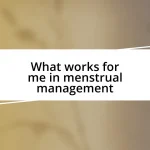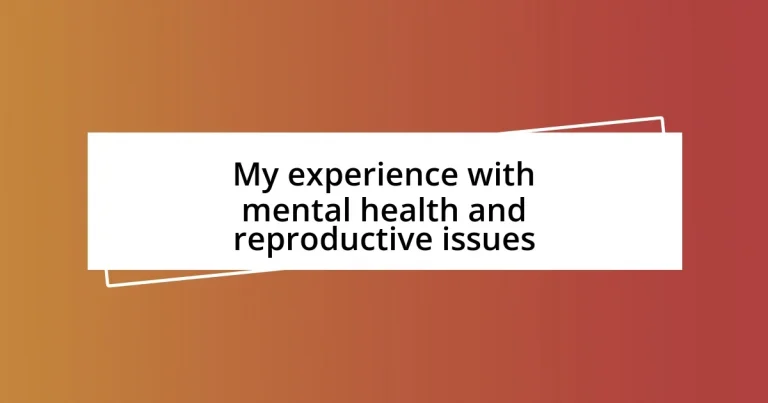Key takeaways:
- Understanding the connections between mental health and reproductive issues can lead to greater self-compassion and awareness of shared experiences, fostering supportive conversations.
- Implementing coping strategies such as mindfulness, physical activity, and creative outlets can significantly improve mental and emotional well-being.
- Seeking professional help and accessing community resources are vital steps in navigating the complexities of mental health and reproductive challenges, offering support and connection.
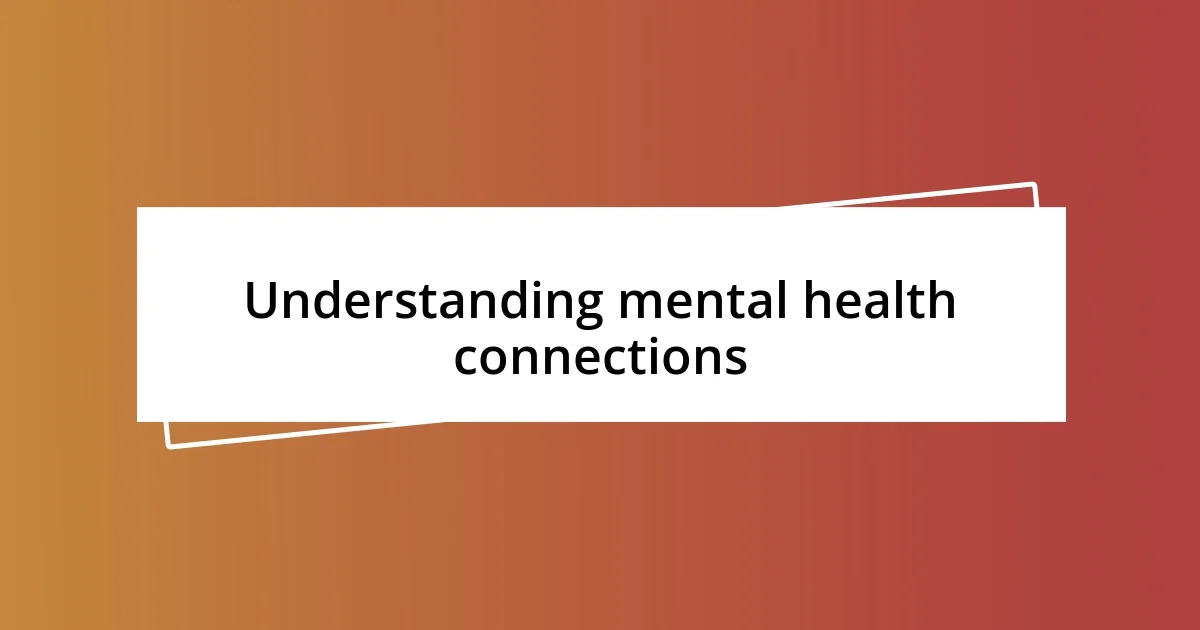
Understanding mental health connections
Understanding the connections between mental health and reproductive issues is often an overlooked but crucial part of our personal experiences. Personally, I remember when my mood swings weren’t just about stress; they intertwined with my monthly cycle, creating a complex web of emotions that felt overwhelming at times. Have you ever felt that subtle shift in your mood that seemed linked to your body’s rhythms, too?
When I began to explore these connections, I realized that hormonal changes can significantly impact mental wellness. It’s fascinating to see how something as biological as reproduction can wave through our mental health, bringing on feelings of anxiety or depression. I often found myself questioning, “Why am I feeling this way?” and seeking clarity became a journey in itself.
Thorough understanding helps us navigate these experiences with more compassion toward ourselves. I remember talking to friends who felt isolated in their struggles, only to discover they shared similar symptoms during specific cycles. It struck me—why do we shy away from discussing these connections when they are so prevalent? Embracing these conversations could lead to greater collective understanding and healing.
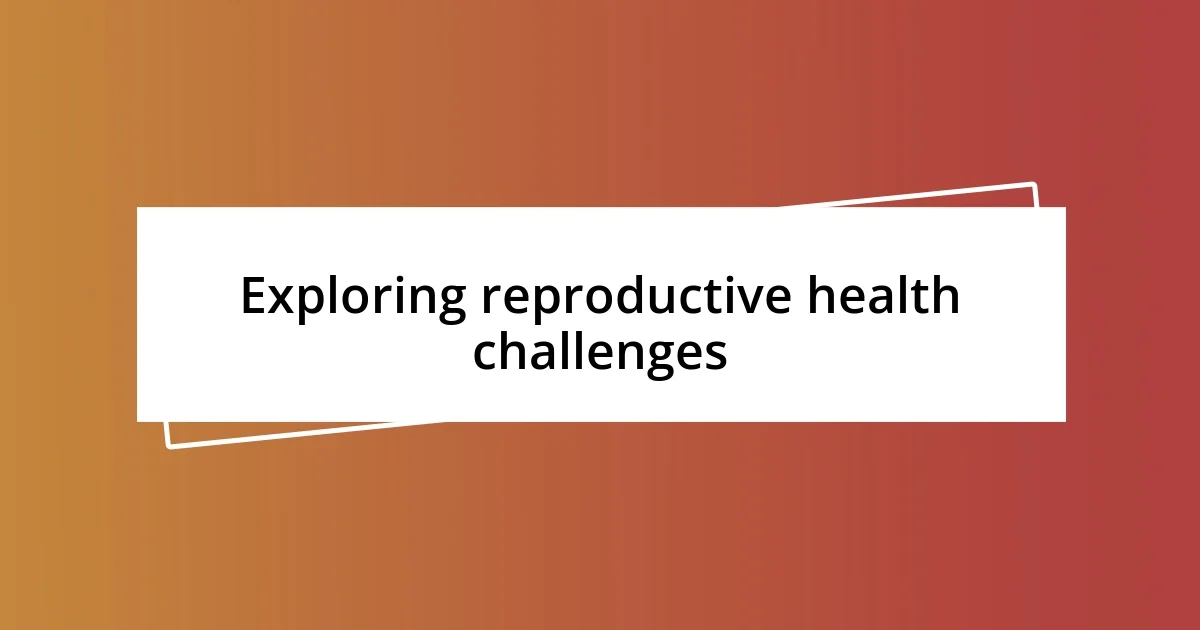
Exploring reproductive health challenges
Exploring reproductive health challenges can be an enlightening and sometimes daunting journey. I vividly recall my experience with severe menstrual cramps, often exacerbated by stress. It was more than just physical pain; it affected my ability to function day-to-day. I’d find myself feeling irritable or anxious, which only deepened the cycle of discomfort. Have you ever noticed how our bodies can have such a profound impact on our minds?
As I began to address these challenges, I learned how common issues like endometriosis can go unspoken, yet they resonate with so many. It’s disheartening to think that many women, including myself, suffer in silence. I remember connecting with a support group where we shared stories, and it struck me how isolating these issues can feel until we voice them. Those conversations brought a sense of solidarity that was both comforting and empowering.
The interplay of reproductive health and mental well-being is a vast ocean of complexity. At times, grappling with fertility concerns led me into a whirlpool of emotions—grief, anxiety, and sometimes anger. Navigating through those feelings required me to be gentle with myself, reminding me that every woman’s path is unique. Have you found solace in sharing similar experiences? It’s a reminder that we often hold the key to understanding each other, especially when we open up about our struggles.
| Reproductive Health Challenges | Mental Health Connections |
|---|---|
| Menstrual disorders (e.g., PMS, Endometriosis) | Increased anxiety and mood swings during cycles |
| Fertility issues | Feelings of grief, fear, and overwhelm |
| Pregnancy-related complications | Postpartum depression and anxiety |
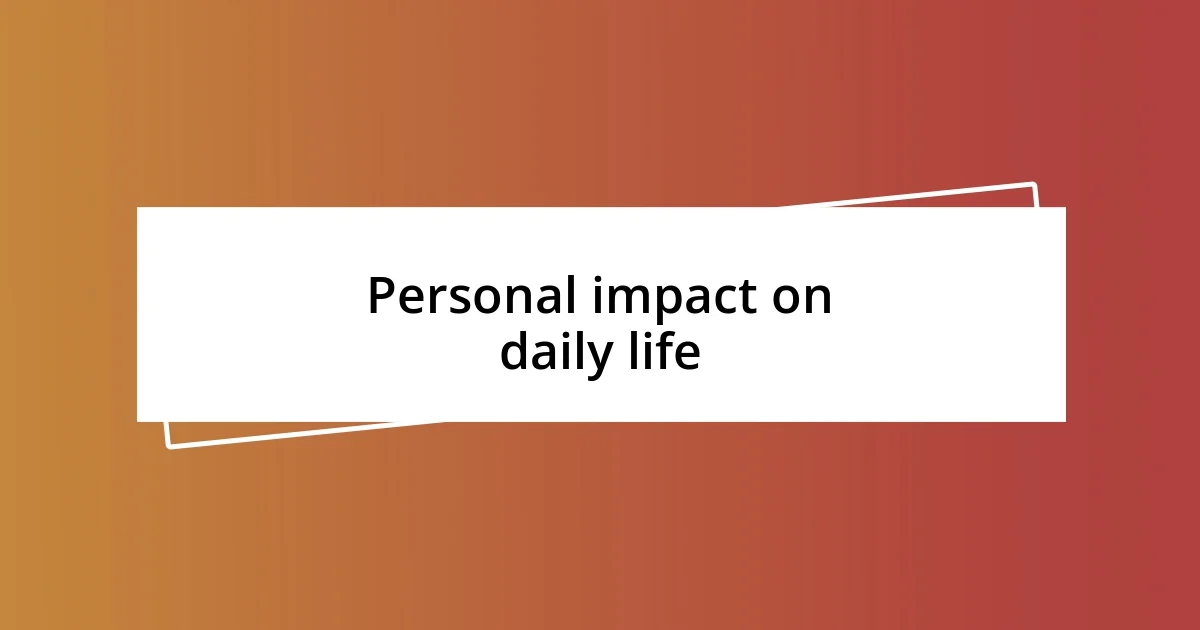
Personal impact on daily life
The impact of mental health and reproductive issues on my daily life was profound, often casting a shadow over the simplest tasks. I can recall moments when I had to cancel plans with friends simply because I felt emotionally drained, caught in the tide of my own anxiety. Each day became a balancing act between managing physical discomfort and mental turmoil, leaving me feeling overwhelmed and sometimes isolated.
Here’s a glimpse of how these challenges manifested in my everyday routine:
- Mood fluctuations: It’s common for me to experience mood swings that skew my interactions, making me more irritable than usual.
- Energy depletion: Some days, the fatigue from cramps or anxiety left me unproductive, turning even the smallest tasks into mountains to climb.
- Social withdrawal: I often chose solitude over social interactions, worrying that I wouldn’t be fun or engaging in my state of mind.
- Decision-making struggles: Simple decisions felt like monumental tasks, influenced by clouds of stress that loomed during particular phases of my cycle.
Recognizing these patterns was the first step toward regaining control over my life. Understanding how intertwined these experiences were helped me to develop self-compassion, allowing myself grace during those tough moments. Instead of pushing through, I began prioritizing self-care, which gradually transformed my days.
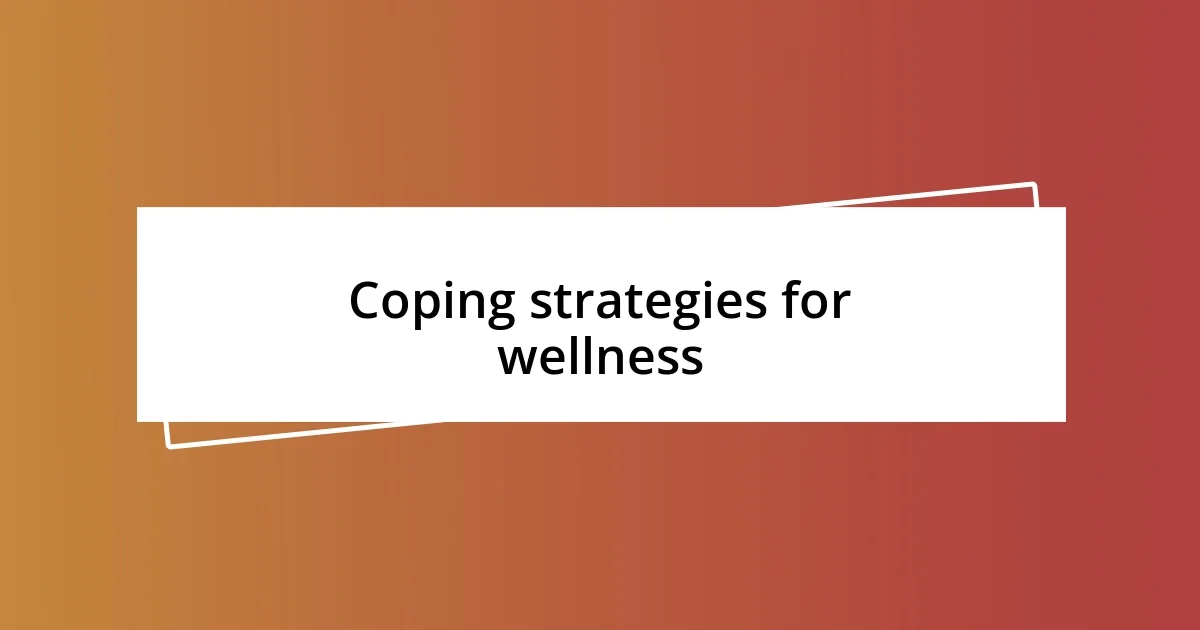
Coping strategies for wellness
Finding effective coping strategies for wellness has been a journey filled with trial and error. One method that worked wonders for me was establishing a daily routine that included mindfulness practices. I remember starting each morning with just five minutes of meditation; it seemed small, but it helped set a positive tone for the day. Have you ever paused to notice how those few quiet moments can shift your mindset?
Physical movement also played a crucial role in my well-being. Initially, I struggled to summon the energy to exercise, but I discovered that even a short walk did magical things for my mood. The fresh air and gentle movement really worked wonders in alleviating tension and anxiety. It’s fascinating how something as simple as stepping outside can ignite a sense of clarity and calm, don’t you think?
Moreover, I turned to creative outlets as a way to process my feelings. Whether it was journaling or painting, expressing myself through art became a release valve for the emotional pressure building inside me. I often found that by channeling my struggles into creativity, I could turn pain into something beautiful and meaningful. Have you explored creativity as a form of self-care? For me, it became not just a coping strategy, but a vital way to connect with my true self amidst the chaos.
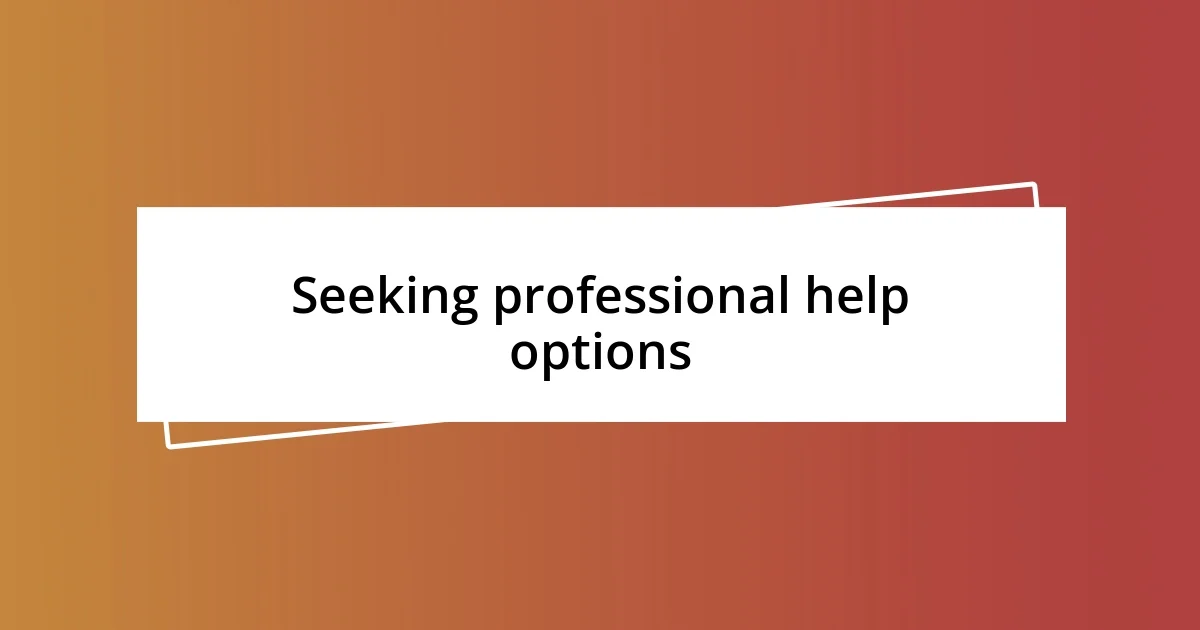
Seeking professional help options
Seeking professional help options can feel daunting, but I’ve learned that it’s a vital step toward healing. I remember my apprehension before making that first call to a therapist—it felt like standing at the edge of a deep pool, hesitant to jump in. But what I found was that this leap of faith opened up a world of understanding and support I had desperately needed.
When considering professional help, it’s crucial to explore the different avenues available. For instance, therapy offers various formats, including in-person sessions, online counseling, and support groups. I personally had a positive experience with teletherapy, where I could connect with a therapist from the comfort of my home—a game changer during particularly tough days. Have you ever felt more at ease discussing your feelings in a familiar space? I believe many people can relate to that.
Medication is another option that deserves consideration, though it’s essential to approach it with care and consultation. I had my reservations, but after thoughtfully discussing it with my healthcare provider, I realized that the right medication could alleviate some burdens. It felt liberating to know that I didn’t have to navigate this journey alone and that there were professionals ready to guide me through the complexities of mental health and reproductive challenges. These options, while unique to each person, can be a vital lifeline toward finding balance and peace.
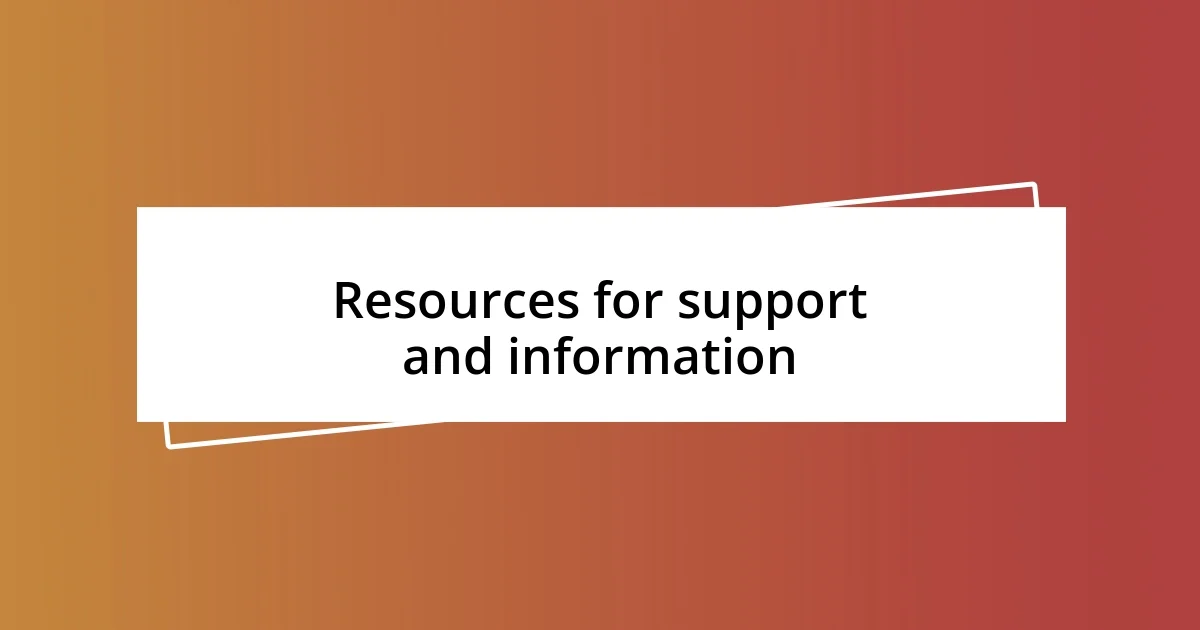
Resources for support and information
Accessing resources for support and information can be life-changing. I remember feeling overwhelmed by the prospect of navigating my mental health and reproductive issues alone, so I sought out various resources. Websites like the National Alliance on Mental Illness (NAMI) and the American Psychological Association provided valuable information and connected me with support groups where I found people who truly understood what I was going through. Have you ever felt a sense of relief just knowing others share your struggles?
Community organizations also played a significant role in my journey. I stumbled upon a local support group specifically for individuals dealing with mental health and reproductive health concerns. Attending these meetings felt like finding a safety net, as we exchanged stories and strategies. There’s something so comforting in realizing you’re part of a community that fosters understanding and empathy, isn’t there?
In addition to traditional resources, I found social media platforms to be an unexpected lifeline. Joining online forums and following mental health advocates allowed me to share my experiences and gain insights from others. I vividly recall a post that resonated deeply with me, sparking a conversation that offered not just advice, but genuine connection. It reinforced my belief that support can come from unexpected places—have you ever discovered comfort in an online community?
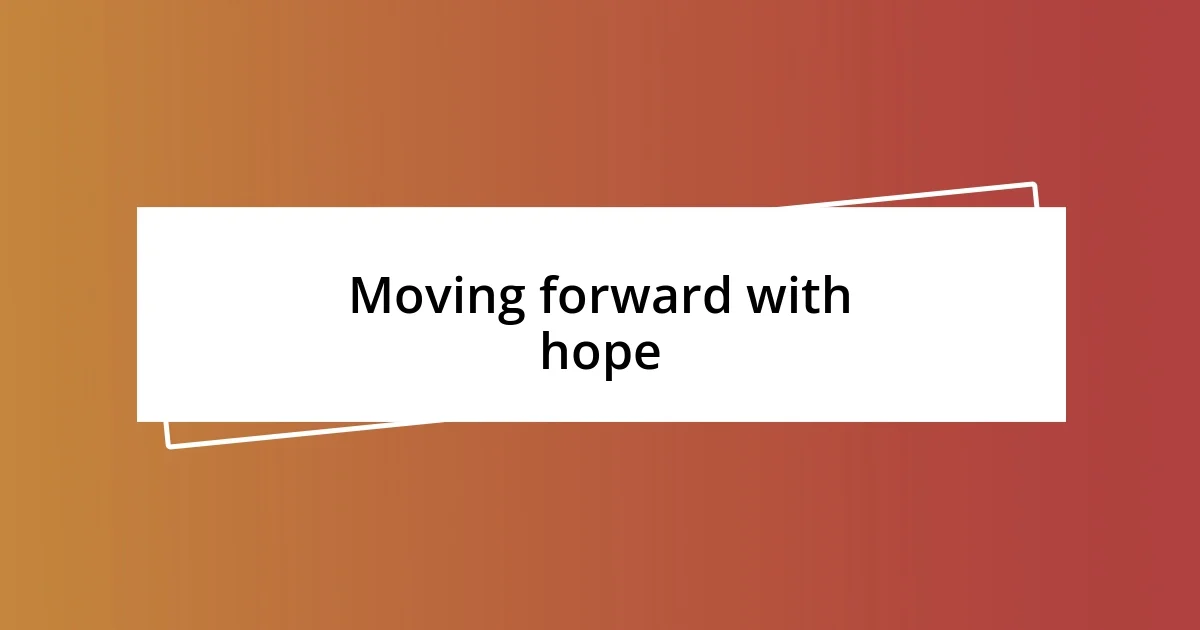
Moving forward with hope
Finding a glimmer of hope is crucial in the journey of mental health and reproductive challenges. One of my most significant lightbulb moments came when I realized that healing isn’t a linear path. There are ups and downs, and that’s perfectly normal. Have you ever felt that spark of hope when you least expected it? I remember a day when a simple conversation with a friend brought warmth to my heart—reminding me that even in dark times, connections can be a source of strength.
As I continued on this journey, mindfulness practices became a game changer for me. I used to think that sitting quietly with my thoughts was daunting, but I discovered that it was a powerful tool for regaining control over my mind. Each meditation session taught me to focus on the present, helping me let go of worries about the future. Isn’t it amazing how something so simple can profoundly reshape our perspectives? This practice allowed hope to flourish, creating space for a brighter vision of my future.
Celebrating small victories also plays a vital role in moving forward. I often jot down things I’m grateful for each day, no matter how minor they may seem. A warm cup of tea, a sunny afternoon, or a kind word from a stranger—they all count! Reflecting on these positive moments nourishes my sense of hope, reinforcing the belief that brighter days are ahead. How often do we overlook these small joys? Embracing them has truly transformed my outlook, reminding me that hope is not just a feeling; it’s a choice I make every single day.
